
OPINION: I’ve been listening to Nura’s products for the past couple of months, and when listening to the NuraTrue Pro, it got me thinking about the accuracy of personalised sound.
Not accuracy in the sense of how Nura measures my hearing, but accuracy in the sense of whether the end result of all that is true to the artist’s intent. And not to single out Nura, as there are a number of brands that offer personalised sound that includes SoundID, Jabra’s MySound and others that take a similar approach.
It’s intriguing because if, say, you’re not as receptive to bass frequencies or high notes and as a result of the personalisation the headphones boost that area, is that performance faithful to whatever the recording artists or production house intended it to be or is it something else?
Are you hearing an artist’s performance through the lens of this personalised soundscape? I suppose if you were to put the point to one of these personalised sound brands, they would say it would allow the listener to hear more. Perhaps you could say just turn it off and go without, as with some personalised sound features I’ve simply not heard a difference with it on or off. But others have realised a better performance to the point where the previous tuning sounds drab and boring.
At least with the Nura headphones I’ve been listening to, the sound quality has been consistent, whether I’m using a true wireless or an over-ear headphone. But I would also say that Nura has an idea about how it wants headphones to sound, like any other headphone maker. Bose has their ideas, which differ from Sony’s philosophy, which is different to Bowers & Wilkins, all informed by history and knowledge. Then you have the effect noise cancellation can have on sound quality, as well as the devices you’re listening on, which can add noise, or with personal music players, subtract it from the signal.

And what further ups the ante is the increase in resolution. More bits and data allow for a better reproduction of music. The NuraTrue Pro are among the first headphones to support Qualcomm’s aptX Lossless, part of the Snapdragon Sound ecosystem. To get the best uncompressed CD quality sound over Bluetooth – at least from Qualcomm’s perspective – you’d need Snapdragon Sound supported products. Throw in personalised sound and will you hear a faithful reproduction of a 24-bit/96kHz file, or one that’s filtered through a personalised perspective? Which one carries more weight in terms of fidelity? What you can hear or what you should be hearing?
I have no idea but, clearly, I do have lots of questions. I suppose at the end of the day if it sounds good to you, then whatever approach works, like it does with headphones that have built-in equaliser options. In that sense you’ve always been able to tailor the sound to what you want, regardless of whether it’s necessary accurate.
I was told once there’s always a degree of compromise in products, that if you want the ‘perfect’ sound, you’d have to pay thousands for that level of fidelity. Everything is a compromise, it’s a case of how much. Want the best sound quality then Tidal, Deezer and Qobuz are better places to start your audio journey than Spotify in terms of fidelity.
So when it comes to “hearing music as it’s meant to be heard”, what does that actually mean? Does that really exists or is that a slogan bandied about. I don’t have the answers but I’m intrigued to find some with this supposedly new era of wireless high fidelity approaching.






